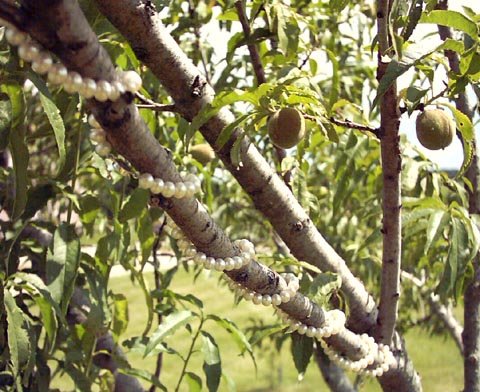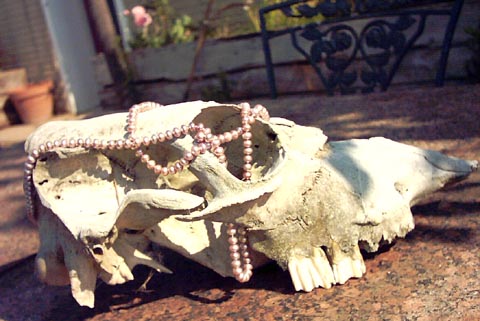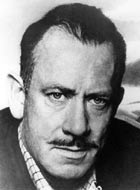|
John Steinbeck The PearlA synopsis of book by John Steinbeck THE PEARL
This guy...John Stienbeck in The Pearl...makes writing seem like a breeze, yet his attention to detail sets the mood and scene perfectly enabling the reader to feel like he's there...sitting silently in the shadows smelling the sea and tasting the rice pudding. A young couple, Kino and Juana, in a poor Mexican fishing village, locked into their ancestral lifestyle of several generations, become desperate for what they feel is necessary...the services of a doctor after their newborn and only child, Coyotito, is stung by a scorpion.
 Temptation as in John Steinbeck The Pearl Peach Tree Pearls by Kari Their quick thinking and use of ancient tribal remedies actually work, but not trusting themselves, they remain desperate for the white doctor's help...even after he refuses to assist the poor village couple because their of lack of money. Their only hope is to find a pearl of great enough price with which to pay the doctor...and as fortune would have it...it is found. Not just a great pearl....but the pearl of all pearls...the largest, most perfect and beautiful pearl ever found. Here is where John Steinbeck's The Pearl gets interesting. Word of their find spreads like a grass fire through the village and reaches the doctor, who is now more than glad to help and who tricks them into thinking they still need his remedy. Suddenly this young couple in John Steinbeck the Pearl have the world open up before them as never before possible...a chance to break out of an existence of poverty and predictability, but also just as suddenly, the world becomes a dark place for them as their eyes are opened to the cheating of the pearl buyers and the greed of someone trying to steal the pearl. Instead of a blessing...the pearl in John Steinbeck The Pearl brings trouble never before encountered for this simple family, or this quiet village. The adventure thickens and fills with murder, fear and revenge...I won't give away the ending...but if you're at all familiar with John Steinbeck's writing...you won't be surprised to know that John Stienbeck's The Pearl doesn't necessarily leave one "feeling good" about anything...but it does leave one with lots to think about. I recommend John Steinbeck The Pearl...but be prepared.
 Death and Intrigue as in John Steinbeck The Pearl Skull Pearls by Kari Book Values of John Steinbeck's booksPrices from: BOOK COLLECTOR'S PRICE GUIDE by Richard Russell, 2003, Krouse Publishers 1. GRAPES OF WRATH by JOHN STEINBECK
2. TRAVELS WITH CHARLEY IN SEARCH OF AMERICA by JOHN STEINBECK
3. OF MICE AND MEN by JOHN STEINBECK
4. CANNERY ROW by JOHN STIENBECK
Search for Books by John Steinbeck the Pearl Here
Dates for Books by John Steinbeck1929: “Cup of Gold” became his first published novel. 1932: “The Pastures of Heaven” became his first published work set in Monterrey County: Corral de Tierra. 1934:A short story set in Monterrey County, “The Murder” won an O. Henry Prize. 1935: “Tortilla Flat” was an instant hit. 1936: “Of Mice and Men,” set around Soledad, was produced as a novel and then as a play; also more of “The Red Pony.” 1937: “The Long Valley” - a collection of short stories set in the Salinas Valley. 1938: “The Grapes of Wrath.” - inspired nationwide attention on the living conditions and exploitation of farm workers. 1940: Film version of “The Grapes of Wrath.” Steinbeck also received the Pulitzer Prize for the novel.
1943: First edition of “The Portable Steinbeck” was published. 1945: “Cannery Row,” which is set in Monterrey. 1945: "Red Pony," published. 1951: “The Log from the Sea of Cortez” published; the work is frequently referred to at the Monterrey Bay Aquarium. 1952: “East of Eden,” his major work about the history of the Salinas Valley, was published. 1960: Traveled through America with his poodle to write “Travels with Charley.”
Biography of John Steinbeck
John Ernst Steinbeck (February 27, 1902 - December 20, 1968)-- one of the most famous American novelists of the 20th century. Awarded the Nobel Prize for literature in 1962, his popularity with readers never was matched by that of the literary critics. He was born to John and Olive Steinbeck in Salinas, California, which acted as a setting for many of his stories. After dropping out of Stanford University followed by an unsuccessful attempt to write in a mythological vein (Cup of Gold), he found his stride in writing California novels and Dust Bowl fiction, set among common people in the Great Depression. His wide range of interests included: marine biology, jazz, politics, philosophy, history, and myth. For many he was the voice of Great Depression. Steinbeck wrote in the naturalist/realist style, often about poor, working-class people. His most famous work, The Grapes of Wrath, tells the story of the Joads, a poor family from Oklahoma and their journey to and subsequent struggles in California. East of Eden is Steinbeck's most ambitious work, in which he turns his attention from social injustice to human psychology, in a Salinas Valley saga loosely patterned on the Garden of Eden story. Steinbeck received the Nobel prize for literature in 1962 for his “realistic and imaginative writings, combining as they do sympathetic humor and keen social perception.” He died in New York. Charles Poore, in an appraisal published in the New York Times the day after Steinbeck's death, said "John Steinbeck's first great book was his last great book. But, what a book that was and is: The Grapes of Wrath." He noted a "preachiness" in Steinbeck's work, "as if half his literary inheritance came from the best of Mark Twain—and the other half from the worst of Cotton Mather." But he asserted that "Steinbeck didn't need the Nobel Prize—the Nobel judges needed him." Poore concluded: "His place in [U. S.] literature is secure. And it lives on in the works of innumerable writers who learned from him how to present the forgotten man unforgettably." In recognition of Steinbeck's work in marine biology with Ed Ricketts, a sea slug species, Eubranchus steinbecki, was named after him in 1987.
Wikipedia
|






